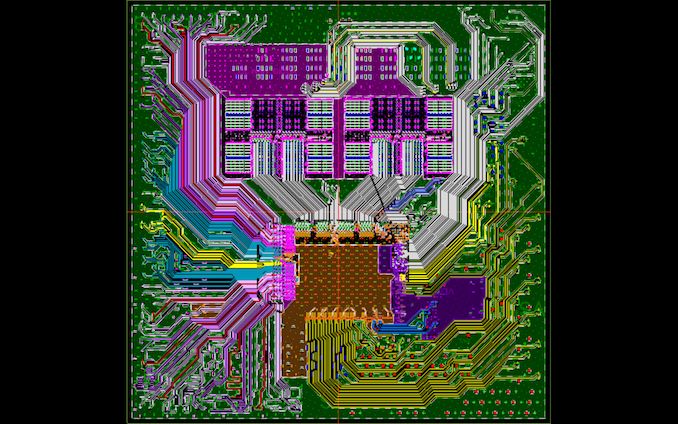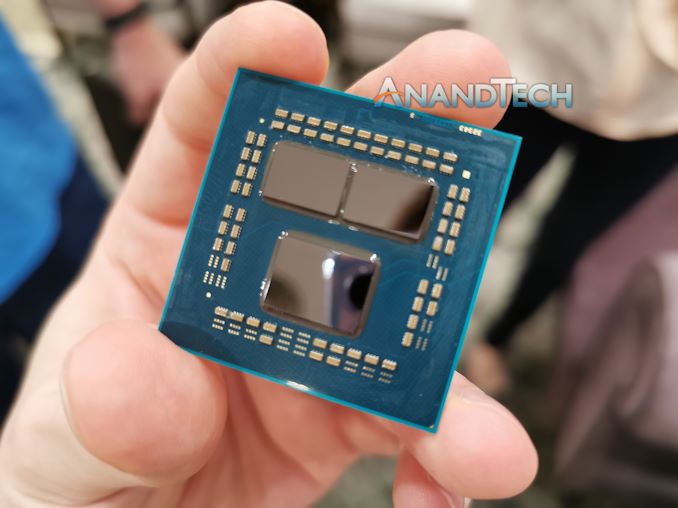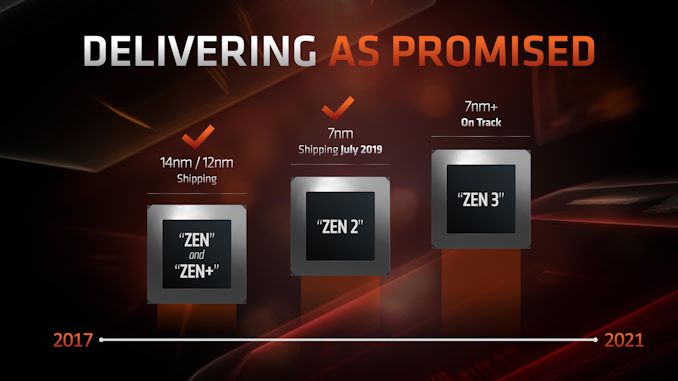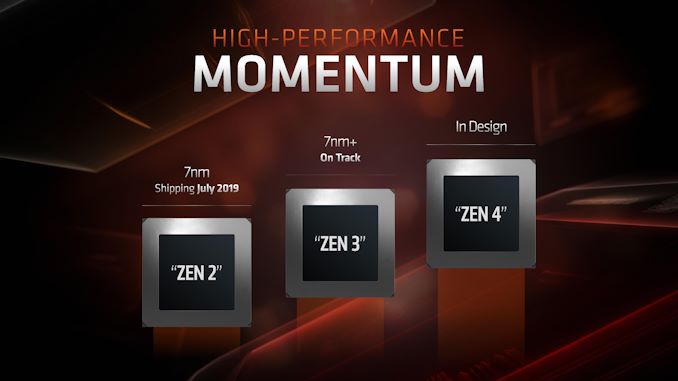AMD Zen 2 Microarchitecture Analysis: Ryzen 3000 and EPYC Rome
by Dr. Ian Cutress on June 10, 2019 7:22 PM EST- Posted in
- CPUs
- AMD
- Ryzen
- EPYC
- Infinity Fabric
- PCIe 4.0
- Zen 2
- Rome
- Ryzen 3000
- Ryzen 3rd Gen

Editor's Note: With Zen 2 set to launch tomorrow (7/7), here's our architecture analysis from last month for some timely background information.
We have been teased with AMD’s next generation processor products for over a year. The new chiplet design has been heralded as a significant breakthrough in driving performance and scalability, especially as it becomes increasingly difficult to create large silicon with high frequencies on smaller and smaller process nodes. AMD is expected to deploy its chiplet paradigm across its processor line, through Ryzen and EPYC, with those chiplets each having eight next-generation Zen 2 cores. Today AMD went into more detail about the Zen 2 core, providing justification for the +15% clock-for-clock performance increase over the previous generation that the company presented at Computex last week.
AMD’s Zen 2 Product Portfolio
The current products that AMD has announced that have Zen 2 cores include the Ryzen 3rd Generation consumer CPUs, known as the Ryzen 3000 family, and AMD’s next generation enterprise EPYC processor, known as Rome. As of today, AMD has announced explicit details of six consumer Ryzen 3000 processors, including core counts, frequencies, memory support, and power. Details about the server processor, aside from some peak values, are expected in due course over the next few months.
| AMD 'Matisse' Ryzen 3000 Series CPUs | |||||||||||
| AnandTech | Cores Threads |
Base Freq |
Boost Freq |
L2 Cache |
L3 Cache |
PCIe 4.0 |
DDR4 | TDP | Price (SEP) |
||
| Ryzen 9 | 3950X | 16C | 32T | 3.5 | 4.7 | 8 MB | 64 MB | 16+4+4 | 3200 | 105W | $749 |
| Ryzen 9 | 3900X | 12C | 24T | 3.8 | 4.6 | 6 MB | 64 MB | 16+4+4 | 3200 | 105W | $499 |
| Ryzen 7 | 3800X | 8C | 16T | 3.9 | 4.5 | 4 MB | 32 MB | 16+4+4 | 3200 | 105W | $399 |
| Ryzen 7 | 3700X | 8C | 16T | 3.6 | 4.4 | 4 MB | 32 MB | 16+4+4 | 3200 | 65W | $329 |
| Ryzen 5 | 3600X | 6C | 12T | 3.8 | 4.4 | 3 MB | 32 MB | 16+4+4 | 3200 | 95W | $249 |
| Ryzen 5 | 3600 | 6C | 12T | 3.6 | 4.2 | 3 MB | 32 MB | 16+4+4 | 3200 | 65W | $199 |
The Zen 2 design paradigm, compared to the first generation of Zen, has changed significantly. The new platform and core implementation is designed around small 8-core chiplets built on TSMC’s 7nm manufacturing process, and measure around 74-80 square millimeters. On these chiplets are two groups of four-cores arranged in a ‘core complex’, or CCX, which contains those four cores and a set of L3 cache – the L3 cache is doubled for Zen 2 over Zen 1.
Each full CPU, regardless of how many chiplets it has, is paired with a central IO die through Infinity Fabric links. The IO die acts as the central hub for all off-chip communications, as it houses all the PCIe lanes for the processor, as well as memory channels, and Infinity Fabric links to other chiplets or other CPUs. The IO die for the EPYC Rome processors is built on Global Foundries' 14nm process, however the consumer processor IO dies (which are smaller and contain fewer features) are built on the Global Foundries 12nm process.
The consumer processors, known as ‘Matisse’ or Ryzen 3rd Gen or Ryzen 3000-series, will be offered with up to two chiplets for sixteen cores. AMD is launching six versions of Matisse on July 7th, from six cores to sixteen cores. The six and eight-core processors have one chiplet, while above this the parts will have two chiplets, but in all cases the IO die is the same. This means that every Zen 2 based Ryzen 3000 processor will have access to 24 PCIe 4.0 lanes and dual channel memory. Based on the announcements today, the prices will range from $199 for the Ryzen 5 3600, up to $700+ for the sixteen core (we’re waiting on final confirmation of this price).
The EPYC Rome processors, built on these Zen 2 chiplets, will have up to eight of them, enabling a platform that can support up to 64 cores. As with the consumer processors, no chiplet can communicate directly with each other – each chiplet will only connect directly to the central IO die. That IO die houses links for eight memory channels, and up to 128 lanes of PCIe 4.0 connectivity.
AMD’s Roadmap
Before diving into the new product line, it is worth recapping where we currently sit in AMD’s planned roadmap.
In previous roadmaps, showcasing AMD’s movement from Zen to Zen 2 and Zen 3, the company has explained that this multi-year structure will showcase Zen in 2017, Zen 2 in 2019, and Zen 3 by 2021. The cadence isn’t exactly a year, as it has depended on AMD’s design and manufacturing abilities, as well as agreements with its partners in the foundries and the current market forces.
AMD has stated that its plan for Zen 2 was to always launch on 7nm, which ended up being TSMC’s 7nm (Global Foundries wasn’t going to be ready in time for 7nm, and ultimately pulled the plug). The next generation Zen 3 is expected to align with an updated 7nm process, and at this point AMD has not made any comment about a potential ‘Zen 2+’ design in the works, although at this point we do not expect to see one.
Beyond Zen 3, AMD has already stated that Zen 4 and Zen 5 are currently in various levels of their respective design stages, although the company has not committed to particular time frames or process node technologies. AMD has stated in the past that the paradigms of these platforms and processor designs are being set 3-5 years in advance, and the company states it has to make big bets every generation to ensure it can remain competitive.
For a small insight into Zen 4, in an interview with Forrest Norrod, SVP of AMD’s Enterprise, Embedded, and Semi-Custom group, at Computex, he exclusively revealed to AnandTech the code name of AMD’s Zen 4 EPYC processor: Genoa.
| AMD EPYC CPU Codenames | |||
| Gen | Year | Name | Cores |
| 1st | 2017 | Naples | 32 x Zen 1 |
| 2nd | 2019 | Rome | 64 x Zen 2 |
| 3rd | 2020 | Milan | ? x Zen 3 |
| 4th | ? | Genoa | ? x Zen 4 |
| 5th | ? | ? | ? x Zen 5 |
Forrest explained that the Zen 5 code name follows a similar pattern, but would not comment on the time frame for the Zen 4 product. Given that the Zen 3 design is expected mid-2020, that would put a Zen 4 product for late 2021/early 2022, if AMD follows its cadence. How this will play into AMD’s consumer roadmap plans is unclear at this point, and will depend on how AMD approaches its chiplet paradigm and any future adjustments to its packaging technology in order to enable further performance improvements.














216 Comments
View All Comments
Teutorix - Tuesday, June 11, 2019 - link
If TDPs are accurate they should reflect power consumption.If a chip needs 95W cooling it's using 95W of power. The heat doesn't come out of nowhere.
zmatt - Tuesday, June 11, 2019 - link
I think technically it would be drawing a more than its TDP. The heat generated by electronics is waste due to the inefficiency of semi conductors. If you had a perfect conductor with zero resistance in a perfect world then it shouldn't make any heat. However the TDP cannot exceed power draw as that's where the heat comes from. How much TDP differs from power draw would depend on a lot of things such as what material the semiconductor is made or, silicon, germanium etc. And I'm sure design also factors in a great deal.If you read Gamers Nexus, they occasionally measure real power draw on systems, https://www.gamersnexus.net/hwreviews/3066-intel-i...
And you can see that draw massively exceeds TDP in some cases, especially at the high end. This makes sense, if semiconductors were only 10% efficient then they wouldn't perform nearly as well as they do.
Teutorix - Tuesday, June 11, 2019 - link
"I think technically it would be drawing a more than its TDP"Yeah, but if a chip is drawing more power than its TDP it is also producing more heat than its TDP. Making the TDP basically a lie.
"The heat generated by electronics is waste due to the inefficiency of semi conductors. If you had a perfect conductor with zero resistance in a perfect world then it shouldn't make any heat"
Essentially yes, there is a lower limit on power consumption but its many orders of magnitude below where we are today.
"How much TDP differs from power draw would depend on a lot of things such as what material the semiconductor is made or, silicon, germanium etc. And I'm sure design also factors in a great deal."
No. TDP = the "intended" thermal output of the device. The themal output is directly equal to the power input. There's nothing that will ever change that. If your chip is drawing 200W, its outputting 200W of heat, end of story.
Intel defines TDP at base clocks, but nobody expects a CPU to sit at base clocks even in extended workloads. So when you have a 9900k for example its TDP is 95W, but only when its at 3.6GHz. If you get up to its all core boost of 4.7 its suddenly draining 200W sustained assuming you have enough cooling.
Speaking of cooling. If you buy a 9900k with a 95W TDP you'd be forgiven for thinking that a hyper 212 with a max capacity of 180W would be more than capable of handling this chip. NOPE. Say goodbye to that 4.7GHz all core boost.
"If you read Gamers Nexus, they occasionally measure real power draw on systems, https://www.gamersnexus.net/hwreviews/3066-intel-i...
And you can see that draw massively exceeds TDP in some cases, especially at the high end. This makes sense, if semiconductors were only 10% efficient then they wouldn't perform nearly as well as they do."
None of that makes any difference. TDP is supposed to represent the cooling capacity needed for the chip. If a "95W" chip can't be sufficiently cooled by a 150W cooler there's a problem.
Both Intel and AMD need to start quoting TDPs that match the boost frequencies they use to market the chips.
Cooe - Tuesday, June 11, 2019 - link
... AMD DOES include boost in their TDP calculations (unlike Intel), and always have. They make their methodology for this calculation freely available & explicit.Spoelie - Wednesday, June 12, 2019 - link
Look at these power tables for 2700Xhttps://www.anandtech.com/show/12625/amd-second-ge...
=>You are only hitting 'TDP' figures at close to full loading, so "frequency max" is not limited by TDP but by the silicon.
=>Slightly lowering frequency *and voltage* really adds up the power savings over many cores. The load table of the 3700 will look on the whole different than for the 3600X. The 3700 will probably lose out in some medium threaded scenarios (not lightly and not heavily threaded)
Gastec - Wednesday, June 12, 2019 - link
That's not actually the real power consumption. Most likely you will get a 3700X with 70-75 W (according to the software app indications) but a bit more if tested with a multimeter. Add to that the inefficiency of the PSU, say 85-90%, and you have about 85 W of real power consumption. Somewhat better than my current 110W i7-860 or the 150+W Intel 9000 series ones I would say :)xrror - Monday, June 10, 2019 - link
funny you say that. AMD TDP and Intel TDP differ. I think.HEY IAN, does AMD still measure TDP as "real" (total) dissipation power or Intel's weaksauce "Typical" dissipation power?
Teutorix - Tuesday, June 11, 2019 - link
Intel rate TDP at base clocks. AMD do something a little more complex.Neither of them reflect real world power consumption for sustained workloads.
FreckledTrout - Tuesday, June 11, 2019 - link
In desktops they are simply starting points for the cooling solution needed. They do a lot better in the laptop/tablet space where TDP's make or break designs.Cooe - Tuesday, June 11, 2019 - link
Yes they do. A 2700X pulls almost exactly 105W under the kind of conditions you describe. Just because Intel's values are completely nonsense doesn't mean they all are.